
How to Peel and Cut Different Fruits and Vegetables
Experienced cooks use a variety of techniques that allow them to peel fruits and vegetables faster and better for further cutting, cooking, or serving. It’s not easy to master all these methods immediately, but even beginners will find something useful in them.
5-Minute Crafts would like to share tips from professional chefs with you which will help you peel and cut different foods depending on their size, shape, and texture.
Strawberries
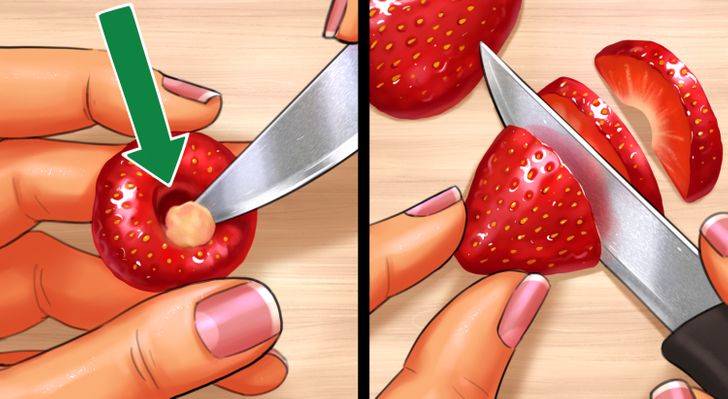
Take a strawberry by its stem and twist it to separate it from the berry. If there is a hard core underneath, use the tip of a sharp small knife to pry it off while rotating the berry. This will remove the core, leaving a smooth, round hole. You can then cut the strawberry into halves, quarters, slices, or wedges.
Coreless strawberries look nicer in a dessert and are more pleasant to eat because you get to enjoy only juicy pulp.
Peach
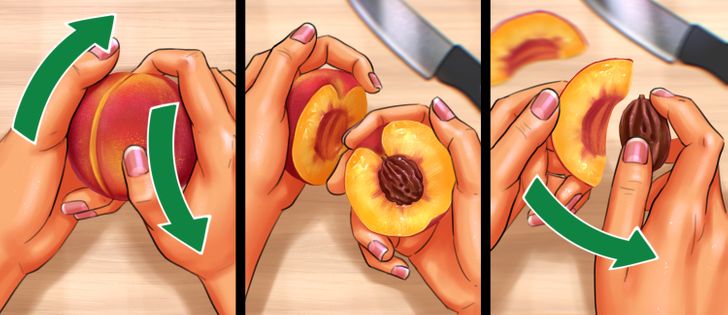
Use a knife to cut a peach in half, going from top to bottom and back again. Now grasp the halves and rotate them in different directions, as shown in the picture above. As a result, you’ll have half with a pit in one hand, and the empty half in the other.
Cut the half with the pit in half again and twist it a little in your hands, separating the quarters from each other, as you did it above. Then take the one that has the pit. Grab the pit with your fingers and pull it toward yourself to separate it from the flesh. If necessary, you can slightly pry it with a spoon. Next, slice the fruit.
Thanks to this method, you can gently remove the pit, almost without damaging the flesh.
Brussels sprouts
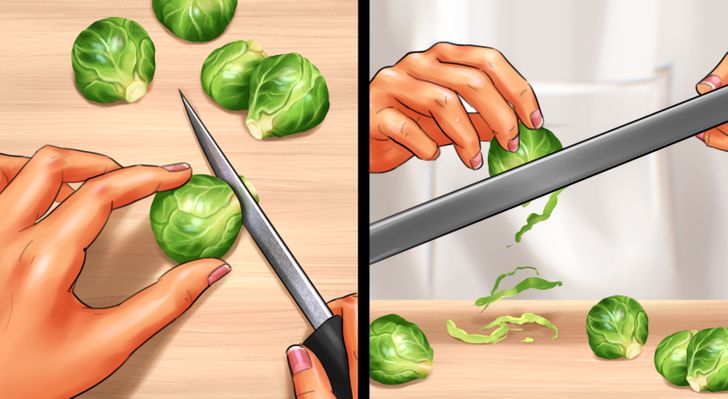
Cut off the hard base of the Brussels sprouts by which they are attached to the stalk. Then you can cut them in half to bake them, steam them, or add them to soup. You can also remove some of the top leaves and chop them to serve in a salad.
Star fruit
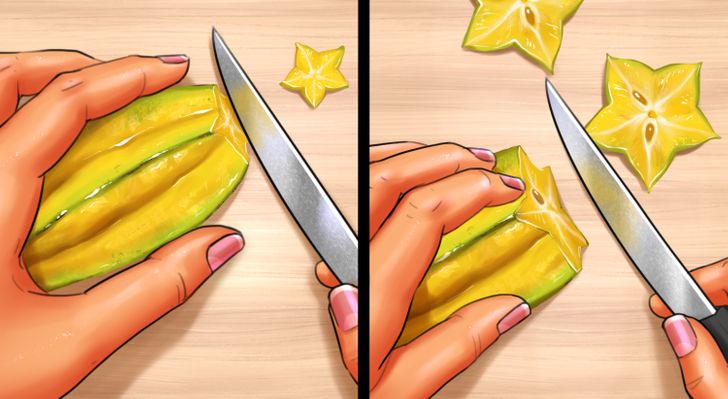
There is no need to peel a star fruit, it’s fully edible. Just cut off the top and bottom of the fruit and then slice it.
Apple
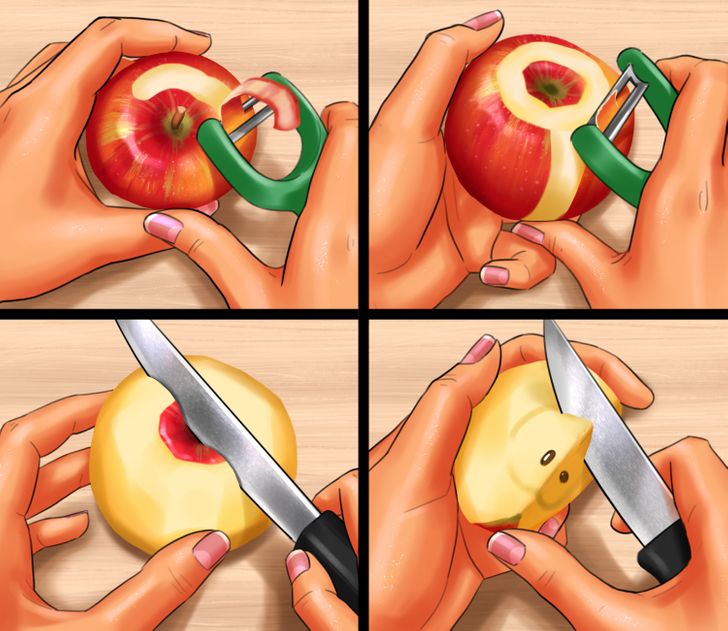
Peel an apple at the top and bottom with a peeler. Then peel off the sides, moving from the top of the apple to the bottom. Cut the peeled fruit into 4 equal parts and use a knife to remove the core with seeds.
Asparagus
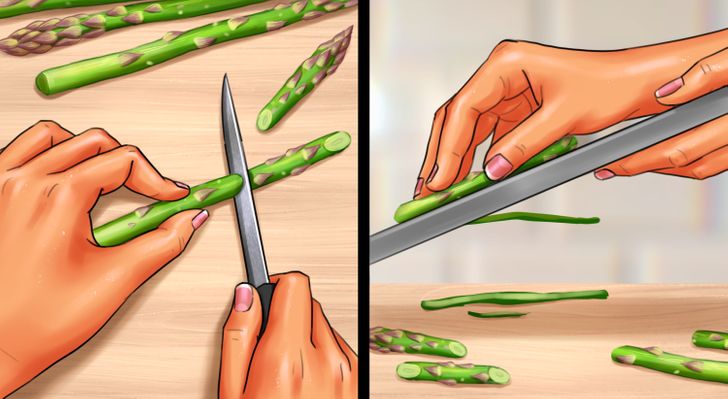
First, rinse the asparagus well. Then break off its hard end. To prepare a sauté, it’s enough to cut the spears at an oblique angle into 2 to 3 pieces. If you plan to grill your asparagus, use whole spears. For salads, you can shred it using a grater.
Rambutan
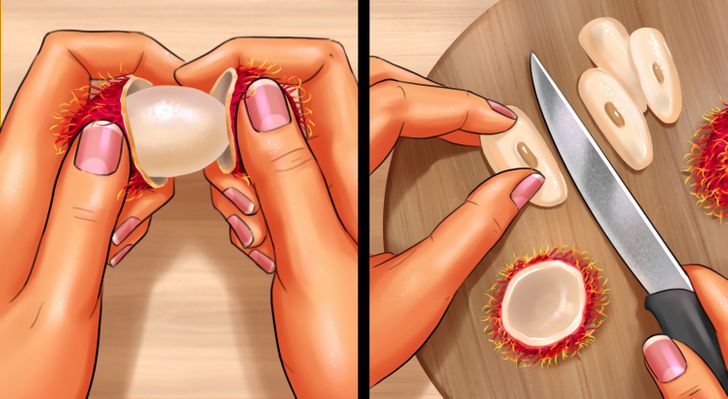
Make a small cut on the skin of the rambutan, near the middle, with the tip of a knife. Then take the fruit with both hands and twist the peel in different directions so that it slides off the pulp.
Cut the flesh into slices. There is a small hard seed inside the rambutan. If it bothers you, trim off the flesh first on the left, then on the right side from the center to get seedless slices.
Avocado
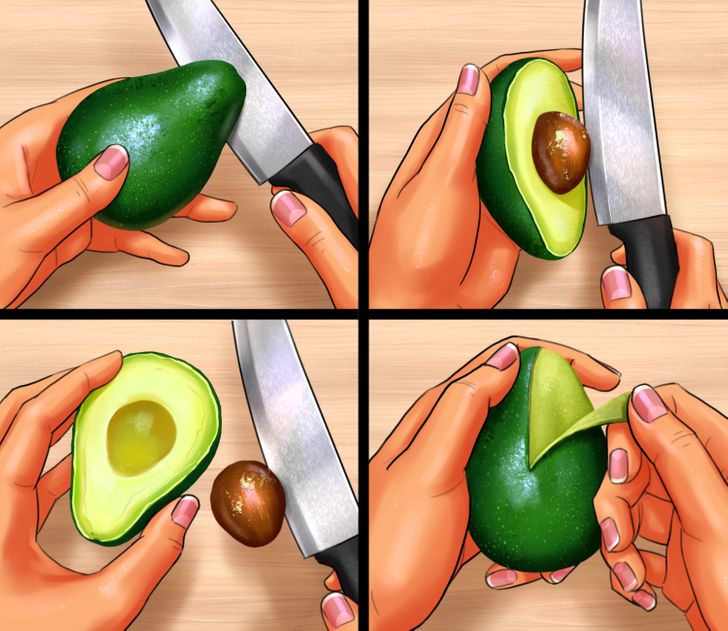
Cut the top of the avocado as shown in the picture above. Then hold the knife tight, and with your other hand, rotate the avocado around the knife, cutting it into 2 pieces. While holding the halves, twist them in different directions to separate them from each other.
Now take the half with the pit. Hit the bone lightly with the knife blade. The blade of the knife should go into it a little.
Then turn the knife blade slightly while holding the fruit tightly. As a result, the pit will be removed from the flesh, remaining attached to the blade. To remove it, hold your palm over the butt of the knife and grab the knife with the fingers of the same hand, then push the pit down. This way, you won’t get cut.
Next, slightly pry the skin of the avocado half and pull it toward yourself to remove. Slice the peeled avocado any way you want.
Persimmon
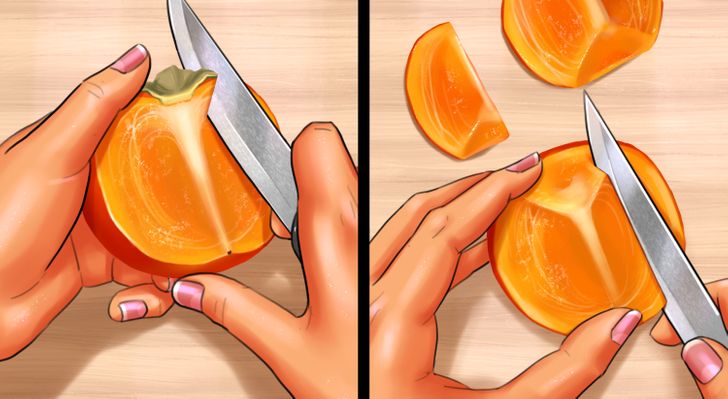
Cut the persimmon in half and remove its core by making a V cut, as if you are coring a tomato. Then it can be cut into wedges, slices, or circles.
Nopal
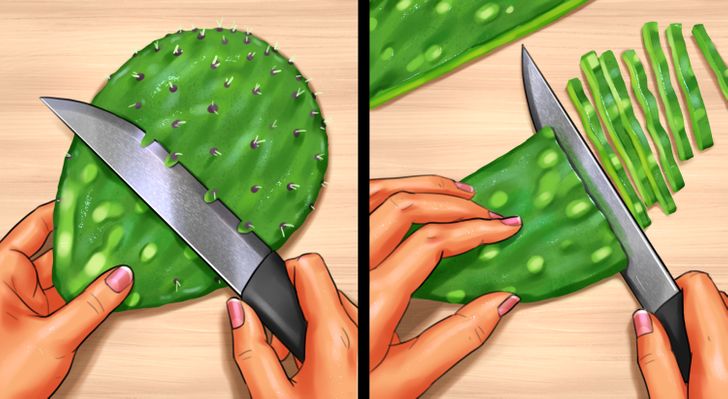
When working with nopal, you should cut off the areas with needles first. To do this, hold the cactus leaf by its base (if necessary, you can wear gloves or wrap the plant with a towel at the base). You can also use a vegetable peeler instead of a knife.
Then cut it into 2 halves, and then slice it into thin long pieces.
Quince
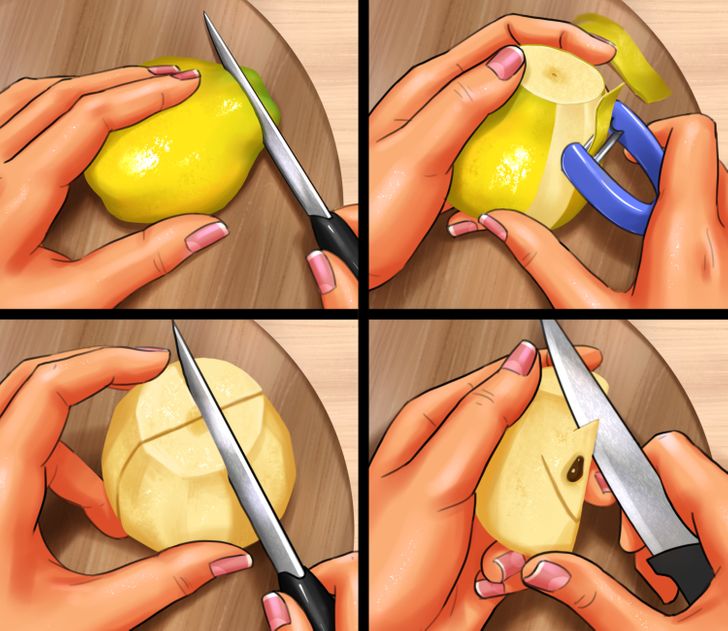
Cut off the top and bottom of the quince. Then use a peeler to remove the skin. Cut the fruit in half and then in quarters. Remove the core with the seeds from each piece. Then cut the quince to your liking, for example into wedges, slices, or cubes.
Dragon fruit
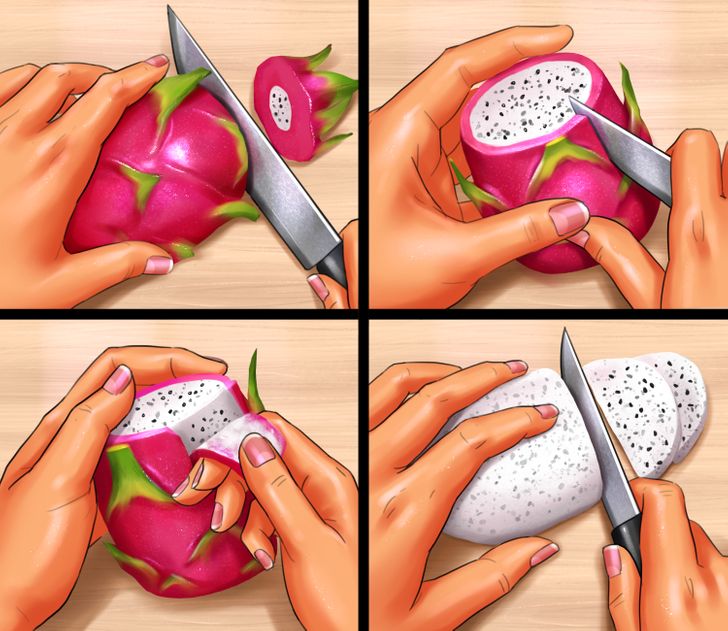
Cut off the top and bottom of the dragon fruit. Using a small knife, make a few shallow cuts along the fruit, from top to bottom, trying to only cut through the skin without touching the flesh.
Then, gently pry the skin from the top or bottom next to the cut with your fingers and pull it toward yourself, removing it from the flesh. Then the flesh can be cut in half and each half can be cut into slices or cubes.
Butternut squash
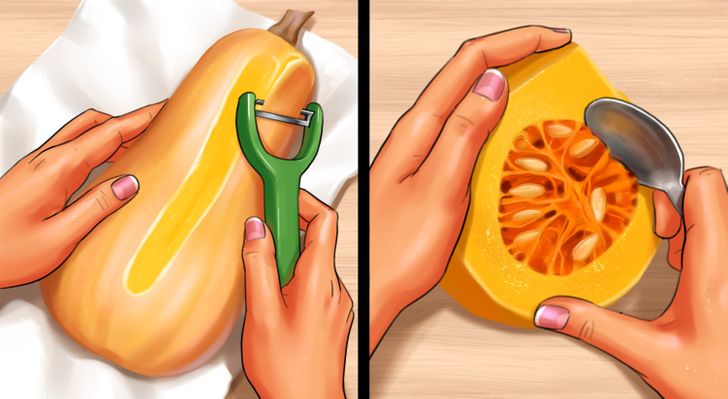
In most cases, the skin of a butternut squash should be removed. To do this, put a towel under the squash and, holding it with one hand, peel it with a peeler while rotating the fruit. Thanks to the towel, the slippery flesh won’t slip out of your hands.
Then you can cut the squash into 2 parts: an oblong one and a round one. Cut the round part in half and scoop out the seeds with a spoon. Then cut off the bottom and top of the squash, and chop the flesh to your liking.
Artichoke
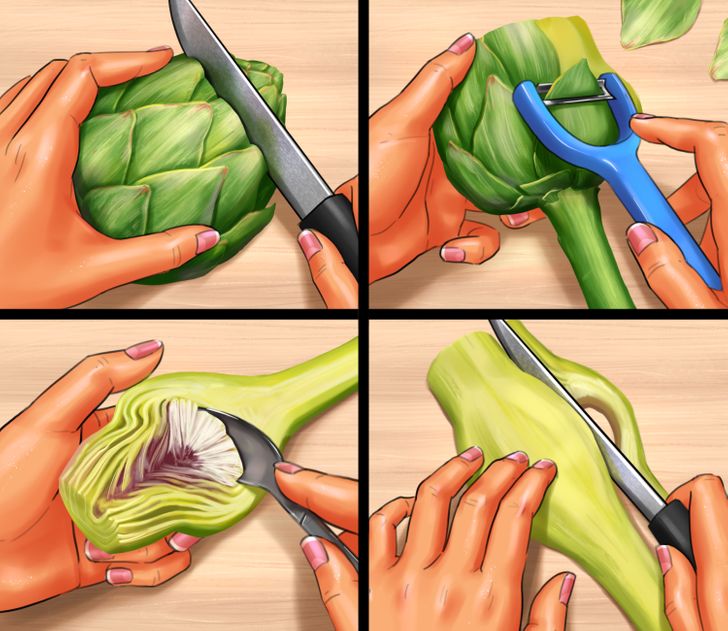
It takes a long time to prepare an artichoke for slicing. Cut off the top first. Then, remove the thick outside leaves to get to the delicate greenery inside. Use a peeler to peel the rough skin on the stem. Cut the vegetable in half and remove the choke and seeds from the middle with a spoon. Then you can cut each piece in half again and grill them, or cut them into strips.
Pomegranate
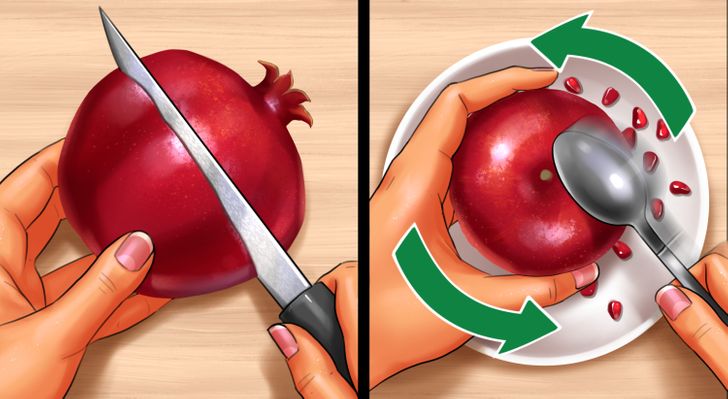
Take a pomegranate and cut it into 2 halves. Put a bowl on the table. Take one half of the pomegranate in your hand so that the cut is facing the palm. Place your hand with the pomegranate over the bowl.
With your other hand, take a spoon and start tapping half of the pomegranate with it while rotating the fruit. As a result, ripe pomegranate seeds will easily fall out onto your hand or directly into a bowl. Repeat the same steps with the other half.
Orange
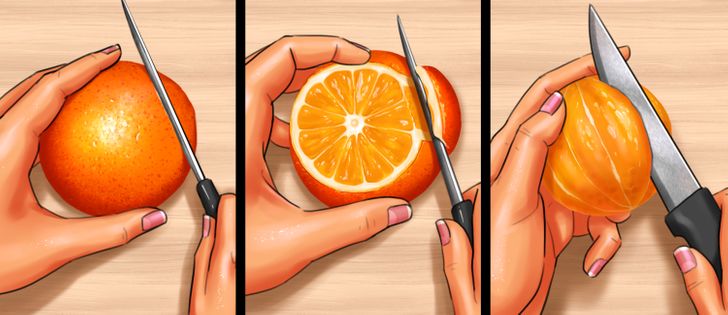
We peel oranges by hand most often. But sometimes we need clean slices of pulp for decoration, for example. To get to them, cut off the top and bottom of the fruit. Then, using a knife, carefully cut off the peel without touching the flesh. Next, remove the remaining white inner part of the peel and the membranes covering the flesh.
Then, using a small sharp knife, cut out each segment between the membranes. As a result, you’ll have segments of orange pulp, without membranes and white pith.
Tomato
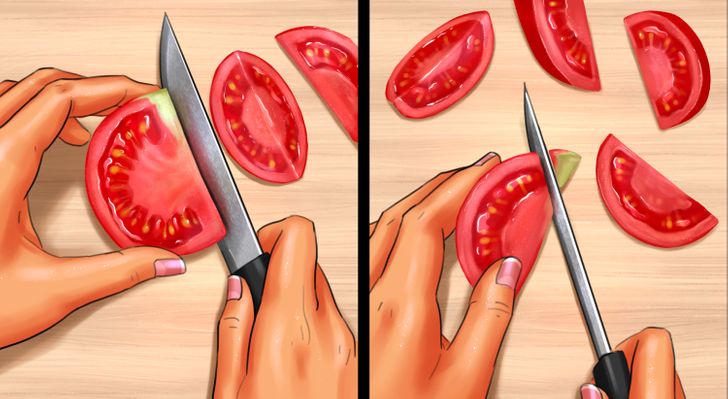
It seems that separate instructions on how to cut a tomato into slices are not necessary. But some people may consider this method convenient if they need to get similar semi-circular slices without a triangular cutout.
Tear off the green stem of the tomato, and cut the fruit in half. Then cut each half into equal semi-circular slices, starting the cut a bit away from the core. As a result, the core will remain on the last slice, from where it can be easily removed with a knife. Repeat your actions with the other half of the tomato.
Mango
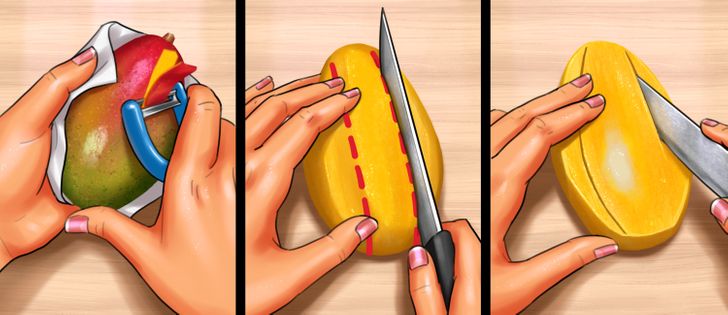
Peel the mango with a peeler. To prevent the fruit from slipping out of your hand, put a paper towel under the peeled side of the fruit.
Take a closer look at the peeled fruit. There is a flat pit inside: the pulp repeats its shape, so you can see its location. To remove the pit, first cut the flesh on the left and right, leaving a gap in the center. Next, turn over the piece with the pit and cut its edges again, moving along the edge of the pit. Then you can cut the flesh to your liking.
Tip: Use a glass.
Once the mango is already cut in half, you can place one of its ends on the lip of the glass, and press gently. Then, simply slide it through, and it’ll be peeled.
Broccoli
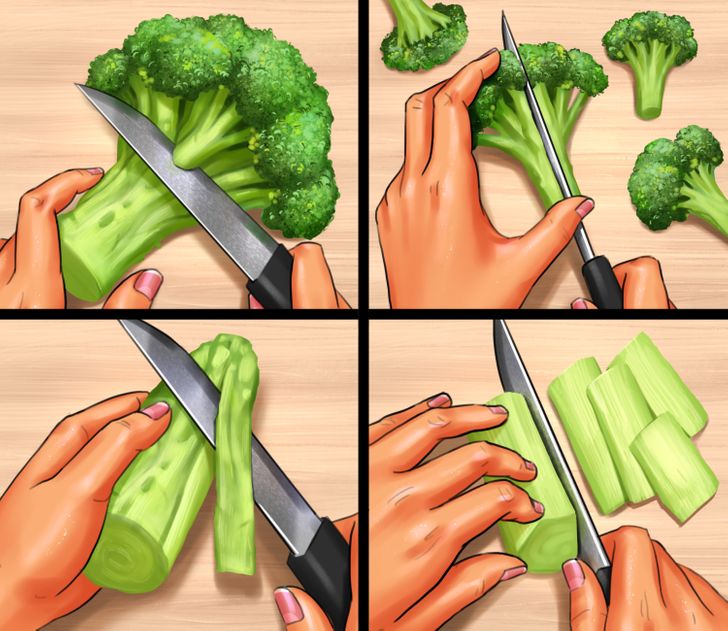
Cut off the broccoli flower buds with a knife, moving along the stalk. Then you can cut each flower in half. Remove the hard skin off the stalk with a sharp knife until you get to the more tender inside. It can be sliced in any convenient way, then steamed, grilled, or stewed.
Papaya
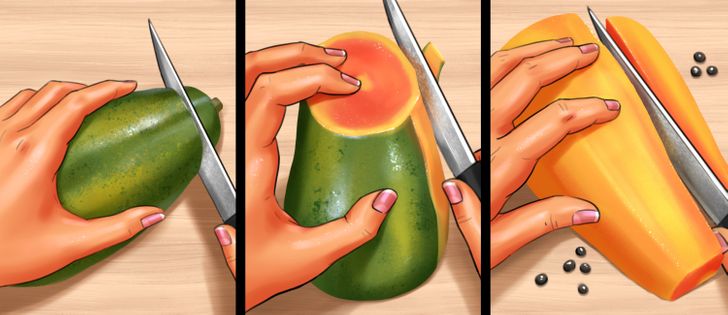
Cut off the top and bottom of the papaya. Then you can cut it in half if you’d like. Using a knife, peel the skin from both halves. You can collect the seeds that fell out during this process in a separate bowl. They are edible and can be used as a nice decoration, for example, as imitation black caviar.
Then cut each half of the papaya in half along its long side and use a spoon to remove the seeds from the center of the fruit. Cut the flesh into wedges, sticks, or cubes.
Ginger
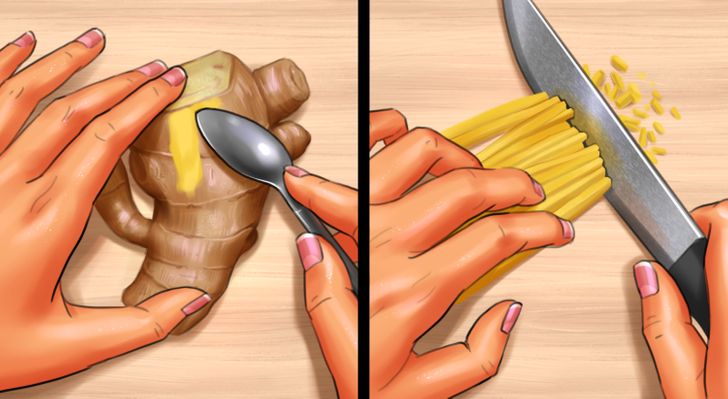
Peel the ginger: you can use a peeler, but it’s better to scrape it with a spoon to remove the thin skin and leave as much flesh as possible.
Choose the way of cutting the ginger to your liking. You can grate it or cut it into thin slices or strips for further fine chopping.
Pineapple
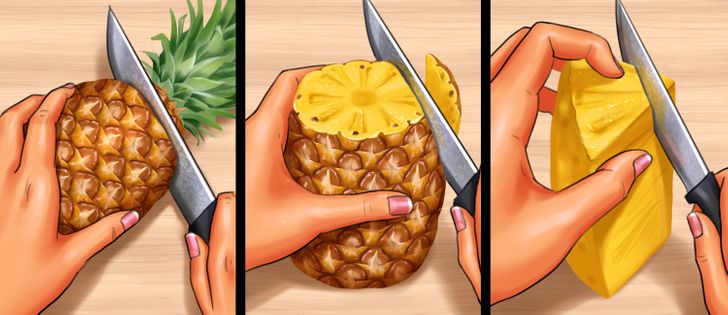
First, cut off the green leaves from the top and cut off the bottom of the pineapple. Then carefully cut off the skin of the fruit. Remove rough areas of the flesh. Next, cut the pineapple in quarters and remove the fibrous part that is closer to the heart of the fruit. Slice to your liking.
Daikon
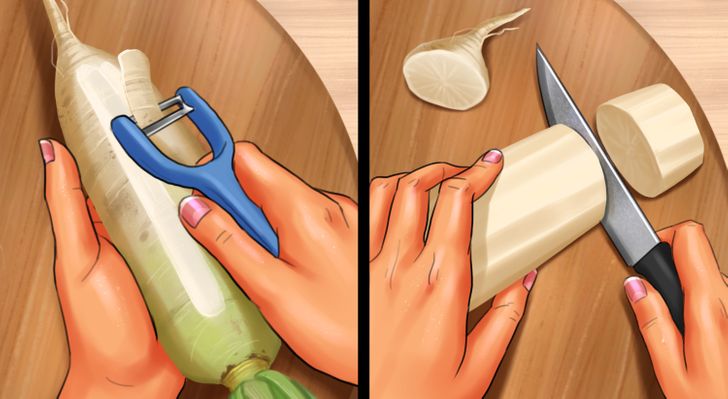
Peel the daikon with a peeler. Cut off its top and bottom, then cut it in half, and if desired, cut each half again in half along the long side. Then cut the vegetable to your liking, for example, into slices or strips.
Cantaloupe
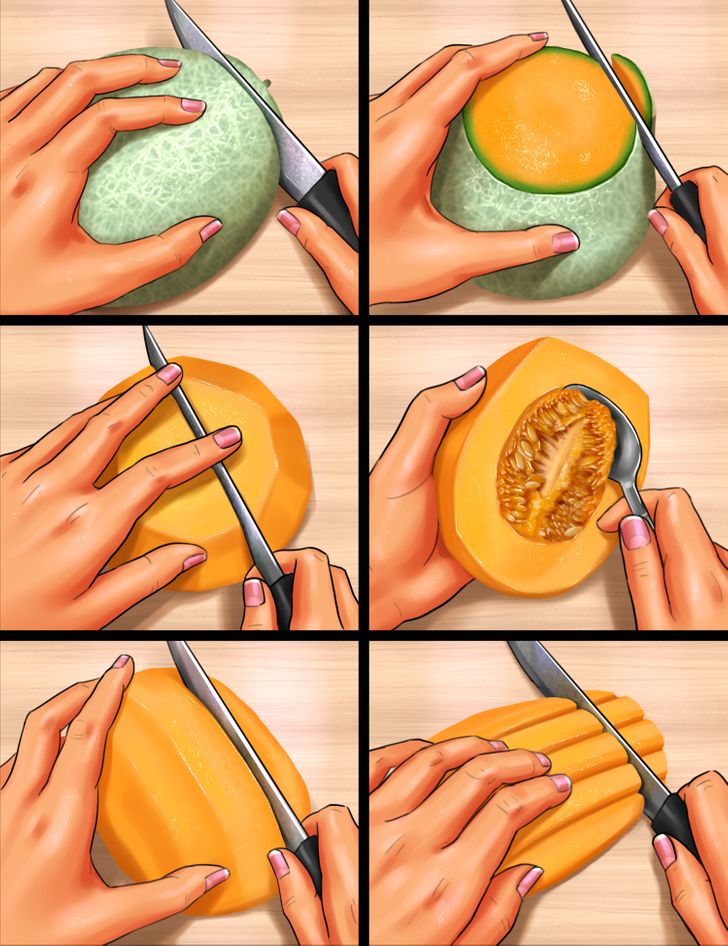
First cut off the top and bottom of the cantaloupe. Then carefully peel the skin off. Cut the fruit in half. Use a spoon to remove the seeds from the middle. Then each half can be cut in half again, and then into slices, sticks, cubes, or any other way.
Watermelon
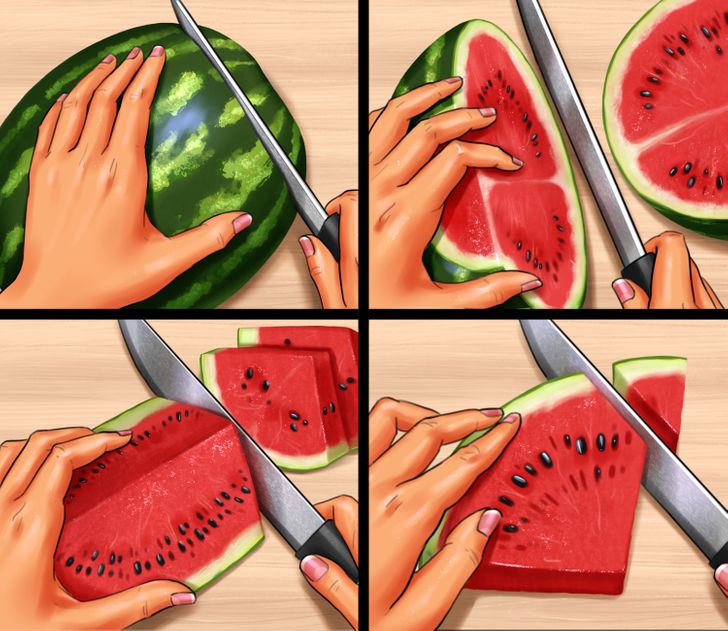
Cut off the top and bottom of the watermelon to make it more stable. Then cut it in half from top to bottom. Cut each half into quarters, then cut each piece into small triangular pieces.
To make these pieces easier to eat, cut off small triangles at the edges of each piece, as shown in the picture above.
Tip: You can also use dental floss once the watermelon is already cut into quarters.
All you need to do is to bring the dental floss to the triangular edges of the fruit, and then slice it underneath it. Afterward, make small incisions to cut the quarter watermelon, into smaller, triangular pieces.